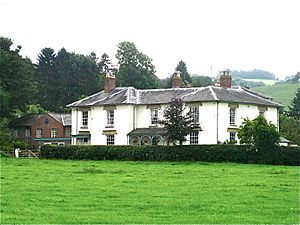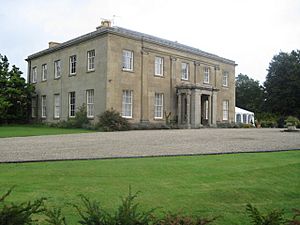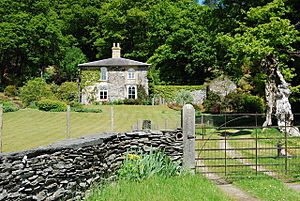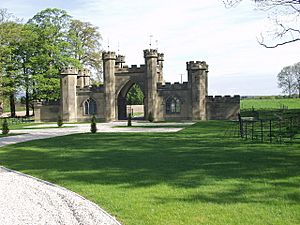Joseph Bromfield facts for kids
Quick facts for kids
Joseph Bromfield
|
|
|---|---|
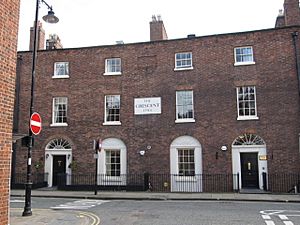
The Crescent, Shrewsbury, built by Bromfield in 1793
|
|
| Born | 1744 ?Whitchurch, Shropshire, England
|
| Died | 1824 Shrewsbury, Shropshire, England
|
| Nationality | English |
| Occupation | Architect |
| Buildings | Glansevern, Rhug, Plas Bodegroes, Nanhoron |
Joseph Bromfield (born 1744, died 1824) was a talented English plasterer and architect. He worked in the West Midlands area of England and in parts of Wales during the late Georgian period (a time when King George III was on the throne). He was also the Mayor of Shrewsbury in 1809, which means he was the leader of the town's government.
Contents
Early Life and Work
Joseph Bromfield was probably born in Whitchurch, Shropshire, in 1744. His father, Robert Bromfield, was also a builder. By 1752, his family had moved to Old Swinford in Worcestershire. There, his father worked at Hagley Hall.
Joseph was one of four brothers. All of them worked in building trades. His youngest brother, Benjamin Bromfield, became a sculptor. He designed and made marble fireplaces for large homes like Chirk Castle. Joseph's father, Robert, knew a Shrewsbury architect named Thomas Farnolls Pritchard. Pritchard is famous for designing the Ironbridge at Ironbridge. Because of this connection, Joseph Bromfield began to create plasterwork for Farnolls Pritchard.
Becoming an Architect
When Farnolls Pritchard died in 1777, Joseph Bromfield decided to become an architect himself. He was very good at drawing plans. He took over Farnolls Pritchard's architecture business. At first, he worked in Shropshire, but his work soon spread across North and Central Wales.
He owned a property called Brannas Lodge near Bala on the River Dee. He seemed to work from there. He designed some important country houses, including Rhug, Caerynwch, and Nanhoron. He also designed rectories (homes for church leaders) in places like Newtown and Llandyssil. He even designed workhouses in Morda (near Oswestry) and Forden (near Montgomery).
Bromfield's buildings often have large bay windows. They also feature "wrap-around" or half "wrap-around" verandas (porches). He was inspired by the Italianate style of villas designed by John Nash. Nash designed Cronkhill near Attingham Park in 1805. Bromfield also worked on Berrington Rectory (later Berrington Hall) and at Attingham. Many of Bromfield's houses have low, sloping roofs with wide eaves, typical of the Regency period.
Joseph Bromfield was one of the first to use cast iron in homes. He probably got the iron from William Hazeldine's factories in Coleham, Shrewsbury and Plas Kynaston. You can see his ironwork at Plas Bodegroes on the Llyn Peninsula. The cast iron downspouts (rain pipes) there are dated 1779. The Rectory at Llandyssil has similar downspouts. It also has cast iron posts supporting the veranda, which were like those used in early factories.
One of Bromfield's most interesting houses is Glansevern Hall. It is located between Welshpool and Newtown. It was finished in 1807 for Sir Arthur Davies Owen. This house is in the Greek Revival style. The stone used to build it came from the Cefn quarries near Wrexham.
Using the Greek Revival style was quite rare at the time. Joseph Bromfield's father worked at Hagley Park, which had an early example of this style. So, Joseph might have gotten the idea from there. He might also have known about the work of Thomas Harrison of Chester, who also used this style. For the lodge at Brannas, Bromfield used rounded "Gothic" arch windows. He seemed to copy Farnolls Pritchard, who liked using Gothic and Chinoiserie (Chinese-inspired) styles. Bromfield also worked in the castellated Gothic style, as seen in his changes to Brynkinallt in 1806.
For a long time, Joseph Bromfield was not well known as an architect. However, more recent studies have shown how important his work was.
Notable Works
Here are some of the buildings Joseph Bromfield worked on:
Plasterwork Projects
- Hartlebury Castle: Plasterwork in Bishop Hurd's Library.
- Ruabon Church: Plasterwork done in 1770-1771.
- Wynnstay: Plasterwork done in 1770-1771.
- Powis Castle: Plasterwork in the Ballroom from 1774-1777.
- St Alkmund, Shrewsbury
- St Chad, Shrewsbury
- Oakley Park
Architectural Designs
- Nanhoron, Llyn Peninsula: Designed for Colonel Richard Edwards in 1797.
- Broomhall, Llyn Peninsula.
- Plas Bodegroes, Llyn Peninsula: Built in 1789.
- Caerynwch, Brithdir, Merioneth: For Sir Richard Richards.
- Brannas Lodge, Llandrillo (believed to be his work).
- Nannau, Llanfachreth: He certainly designed the part of the house that was later taken down (1806). The main house is also thought to be his work.
- Glanllyn, Llyn Peninsula (believed to be his work).
- Rhug: For Colonel Edward Vaughan Salisbury (1802–1805).
- Rhagatt (believed to be his work).
Buildings in Montgomeryshire
- Newtown Rectory: Built in 1812.
- Llandyssil Rectory: For the Reverend Devereux Mytton (1812–1814).
- Glansevern, Berriew: A Greek Revival style house and gate lodge for Sir Arthur Davies Owen (1803–1807).
- Rhiwport, Berriew (believed to be his work, has a typical veranda).
- St Nicholas, Churchstoke: Alterations to the Church tower (1814–1815).
- Forden Workhouse: Built in 1794–1795.
Buildings in Denbighshire
- Brynkinallt, Chirk, near Ruabon: He redesigned the outside of the house for the 2nd Viscount Dungannon in 1806. He added Gothic castle-like towers, which have since been removed. The Gothic gatehouse to the park was also probably designed by him.
Buildings in Shropshire
- Morda Workhouse, Oswestry.
- Styche Hall: Alterations made from 1796–1798.
- Apley Castle: For St John Charlton (1791–1794). This building was taken down in 1955.
- Attingham Park Lodges: Built from 1796–1799.
- Church Aston Church: Around 1800.
- Berrington Rectory (later Berrington Hall): Built in 1805.
- Acton Scott Hall: Remodeled for Thomas Stackhouse Acton (around 1810-1820).
- Walcot Hall: Redesigned the front and portico (entrance) from 1784–1790 for 2nd Lord Clive.
- Sham Castle (believed to be his work).
- The Crescent, Shrewsbury: Built in 1793.
- 37 St Julians Friars, Shrewsbury: Bromfield's own house in Shrewsbury, with beautiful plasterwork. It is now the Sandford House Hotel.


